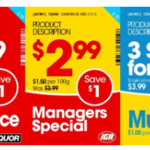A frequent obstacle when it comes to carrying out the retail ticketing process in-store is the perceived cost of printing. To avoid these costs, head offices and individual stores will opt for centralised printing, often on pre-printed card stock. This method, however, has serious shortcomings.
Centralised print carries production, printing and distribution costs. It also involves inefficiency and unnecessary waste. All promotions have to be planned weeks or months in advance. Printing and shipping delays, or printing errors and damage, mean that promotions are late to store.
Having the freedom to print tickets in-store, with the right ticketing platform, removes all logistical drawbacks while maintaining continuity and compliance across stores. Stores are understandably hesitant to go down this self-print path because they fear the costs will be too high, so let’s take a look at what costs are involved, how it works and the benefits of being on a Managed Print Service (MPS).
Perceived Costs Involved
Printing: Initial Outlay and Price Per Copy
There are two costs for MPS. The first is the initial outlay for the printer, which will be purchased with a 12-month to 5-year warranty. The price of printers varies depending on make and model, however, if we assume an average price of $700 with a warranty period of five years, that works out to $140 a year, per store. That’s a relatively affordable hardware cost per year.
The second cost is the price per copy. This charge is the only ongoing cost paid throughout an MPS agreement. The number of pages printed per month is tallied and charged at a set price. The pricing per copy is dependent on a couple of factors. The first is whether tickets are in colour or mono. If in colour, the price will change based on whether the tickets are high coverage or low coverage.
The price per copy is heavily dependent on the supplier that is chosen. However, using an average price, we can get an idea of cost and value. Let’s assume a cost per copy of 0.18c for full coverage, 9up colour tickets. One thousand pages of 9ups would cost $180. That equals 9000, 9up, full-colour tickets, for $180 per store.
When printing in mono the cost is even less. Mono printing will average 0.02c per copy. In this instance, one thousand pages of 9ups would cost a store $20. That’s 9000, 9up, mono tickets, for $20 per store.
It is also worth noting that pre-printed paper stock can still be used with MPS. While there are numerous benefits to printing in full colour, realistically stores or groups may have already invested in a pre-printed stock that needs to be used.
This is not an issue if you are using a flexible ticketing platform. In this instance, the templates being used would need to be adjusted, or custom templates made, to accommodate the header and footer. Once this is done, you can print on any existing paper stock as normal.
Toner
One of the biggest areas of concern when it comes to printing tickets in-store is the ongoing costs of toner/ink. This can be a considerable expense if you are managing your printing. An ordinary printer will certainly burn through toner at a fast pace.
Under MPS however, all that is paid for is the cost per copy, which means all printer consumables are rolled into that cost. Toner use is monitored and ordering is automated. When toner levels reach a certain threshold an order is triggered in the system and the replacement toner is shipped to the store. There is no need for staff members to keep track of consumables. Spare printer parts such as waste toners and drum cartridges are also under automated ordering.
Ongoing Maintenance
Printers break. This is an undeniable and irritating fact of life. Especially when printing at a high volume on perforated paper. Some stores can print off thousands of tickets and never have a problem. Other stores are a little more unlucky and experience some technical difficulties. Maintaining hardware is one reason stores are reluctant to move the printing process in house. However, if you’re on MPS with a warranty, a broken printer is a very manageable inconvenience.
Relatively speaking, there are few instances where a printer will break down and be completely unable to print tickets. A lot of problems can be overcome with troubleshooting if you have the patience. Or if you are faced with a problem well beyond your technical skills, a printer covered by a warranty will include on-site technical support.
Depending on your supplier and location, most support will be the next business day, or two days if the store is in a more remote location. Therefore even if the printer stops working, it should be up and running by the next business day. If there is a very serious issue that takes longer to resolve, a temporary printer will likely be provided so a store can continue to print tickets. In the rare instances a printer breaks completely and is unfixable, a warranty ensures the printer will be replaced.
The Benefits of Managed Print Service
Now we know how MPS works and, on average, what costs can be expected, let’s take a quick look at the benefits of moving from centralised print to in-store printing.
Compliance and Correct Pricing
One of the arguments for centralised printing across store groups is the issue of compliance. Printing and shipping tickets from a central location to a store network means that all stores have the same pricing and there is absolutely no chance that a store’s pricing will differ from that dictated by head office.
However this is not the only way to make sure stores are compliant with head office pricing. When stores use software specifically designed for creating and distributing shelf edge tickets, head offices can create batches and assign them to stores with the dates of when the promotions should run. The stores can then print these tickets at the time and in the quantity necessary.
Furthermore, software that includes reporting makes it easy for head offices to police which stores have printed and which haven’t. In this way, stores can print their promotional shelf edge tickets, without the need for centralised printing to keep stores compliant. Head offices, or individual stores, are in full control over product and price points and are not restricted to a centralised printer for store compliance.
Flexibility
Centralised print does not allow for any flexibility at either a head office or a store level. There is no freedom over what promotions to run, when to run them, what the tickets look like or what size talker gets used. Handling printing at the store level allows individual owners or managers to make decisions regarding what promotions should be run in addition to those advertised in catalogues or dictated by head office.
Stores will also have the option of what style templates are used and in what size. Not all stores have the same amount of shelf space and can accommodate same size talkers. One store might be able to hang a 2up while another might require a 9up.
This flexibility is still advantageous when head offices want full control over ticket creation at the store level. As noted in the above section, with the right ticketing software, head offices can create batches and distribute them to a store group, controlling exactly what they are permitted to print.
However, it is still beneficial for head offices not to be locked into promotions, pricing and designs because they have already been printed at a central location. In-store printing gives head offices the freedom to operate and dictate their timeline, not be bound by the deadlines of a third-party centralised print service.
More so, when utilising ticketing, solution marketing departments will no longer have to spend time designing edge-of-shelf and promotional tickets, instead they can be created according to automated design rules. It’s as easy as choosing a template and entering the pricing information.
Print Order
In-store print allows stores to print off their tickets in planogram order. When receiving tickets that have been shipped from a centralised printer, tickets are in a completely random order. Tickets then have to be unpacked, sorted and correctly ordered so they can then be hung on the shelf.
This is a needlessly time-consuming operation. Ticketing done at the store level can avoid this hassle. Tickets are printed off in planogram order and are ready to be hung on the shelf edge straight away.
Logistics
As we briefly touched on earlier in this article, there are serious logistical advantages to moving off a centralised print model. First and foremost, there is no advanced planning required for printing promotional tickets in-store. All printing and hanging can be done together, at the time the promotion is going to run.
When tickets are being printed in-store, each store can print the exact amount of tickets required, removing the waste of overprinting or the dilemma of not printing enough tickets. Additionally, the ongoing production, printing and distribution costs are eliminated and replaced with a cost-per-copy system.
There are numerous advantages to printing tickets at the store level and MPS makes this possible. The costs of being on MPS might be slightly higher, but not prohibitively so, as we’ve seen from the costings earlier in this article. The question is, what is the real cost of continuing with the process of centralised print?
Monetary considerations must be measured against operational efficiency. The move away from centralised print for retail to the use of MPS makes sense for several reasons. The main reason is the freedom of decision-making that in-store printing affords.
Once a batch of tickets has been sent off to a printer, that’s it, there is no chance to make adjustments. There is simply no way to react in real-time to any changes in customer behaviour. If there are pricing or spelling errors on the tickets everything has to be reprinted and reshipped. Pricing isn’t up to date, promotions don’t match the advertised price in catalogues, the shelf edge is wrong and customers are confused and annoyed. Printing in-store eliminates all these issues.
From a head office perspective, centralised print gives full control over what appears in stores. However, allowing printing at a store level doesn’t mean relinquishing that control. When using a ticketing solution, head office can assign batches to stores, thus retaining the ability to dictate and oversee what stores are printing. Ultimately, in-store printing affords retail environments increased flexibility and efficiency, as well as a vastly improved ability to react to shopper trends and influence spending that centralised printing simply cannot.
What’s next?
We hope you found these ideas useful. Like to see these strategies in action? Book a discovery call for a quick 15-minute demo with real-world examples you can share with your team.


